Potrebujeme váš súhlas na využitie jednotlivých dát, aby sa vám okrem iného mohli ukazovať informácie týkajúce sa vašich záujmov. Súhlas udelíte kliknutím na tlačidlo „OK“.
ASTM D7201-06(2011)
Standard Practice for Sampling and Counting Airborne Fibers, Including Asbestos Fibers, in the Workplace, by Phase Contrast Microscopy (with an Option of Transmission Electron Microscopy)
Automaticky preložený názov:
Štandardná prax pre odber vzoriek a počítanie vlákien v ovzduší, vrátane azbestových vlákien, na pracovisku, fázovým kontrastom mikroskopia (s možnosťou transmisný elektrónovej mikroskopie)
NORMA vydaná dňa 1.10.2011
Informácie o norme:
Označenie normy: ASTM D7201-06(2011)
Poznámka: NEPLATNÁ
Dátum vydania normy: 1.10.2011
Kód tovaru: NS-37845
Počet strán: 24
Približná hmotnosť: 72 g (0.16 libier)
Krajina: Americká technická norma
Kategória: Technické normy ASTM
Kategórie - podobné normy:
Anotácia textu normy ASTM D7201-06(2011) :
Keywords:
air monitoring, asbestos, fibers, membrane filter method, phase contrast microscopy, sampling and analysis, workplace atmospheres: Air monitoring, Asbestos, Fibers, Membrane filters (MF), Phase contrast microscopy, Sampling, Transmission electron microscopy (TEM), Workplace air/atmospheres, ICS Number Code 13.040.30 (Workplace atmospheres)
Doplňujúce informácie
| Significance and Use | ||||||||||||||||||||||||
|
Users of this practice must determine for themselves whether the practices described meet the requirements of local or national authorities regulating asbestos or other fibrous hazards. Variations of this practice have been described by the Asbestos Research Council in Great Britain (8), the Asbestos International Association (AIA) RTM 1 (9), NIOSH 7400, OSHA (Reference Method ID 160), and ISO 8672. Where the counting rules of the latter three methods differ, this is noted in the text. Advantages The technique is specific for fibers. PCM is a fiber counting technique that excludes non-fibrous particles from the analysis. The technique is inexpensive, but requires specialized knowledge to carry out the analysis for total fiber counts, at least in so far as the analyst is often required under regulations to have taken a specific training course (for example, NIOSH 582, or equivalent). The analysis is quick and can be performed on-site for rapid determination of the concentrations of airborne fibers. Limitations The main limitation of PCM is that fibers are not identified. All fibers within the specified dimensional range are counted. Differential fiber counting may sometimes be used to discriminate between asbestos fibers and fibers of obviously different morphology, such as cellulose and glass fiber. In most situations, differential fiber counting cannot be used to adequately differentiate asbestos from non-asbestos fibers for purposes of compliance with regulations without additional positive identification. If positive identification of asbestos is required, this must be performed by polarized light or electron microscopy techniques, using a different portion of the filter. A further limitation is that the smallest fibers visible by PCM are about 0.2 μm in diameter, while the finest asbestos fibers may be as small as 0.02 μm in diameter. Where calculation of fiber concentration provides a result exceeding the regulatory standard, non-compliance is assumed unless it can be proven that the fibers counted do not belong to a member or members of the group of fibers regulated by that standard. |
||||||||||||||||||||||||
| 1. Scope | ||||||||||||||||||||||||
|
1.1 This practice describes the determination of the concentration of fibers, expressed as the number of such fibers per millilitre of air, using phase contrast microscopy and optionally transmission electron microscopy to evaluate particulate material collected on a membrane filter in the breathing zone of an individual or by area sampling in a specific location. This practice is based on the core procedures provided in the International Organization for Standardization (ISO) Standard ISO 8672 (1) , the National Institute for Occupational and Health (NIOSH) Manual of Analytical Methods, NIOSH 7400 (2), and the Occupational Safety and Health Administration (OSHA) Method ID 160 (3). This practice indicates the important points where these methods differ, and provides information regarding the differences, which will allow the user to select the most appropriate procedure for a particular application. However, selecting portions of procedures from different published methods generally requires a user to report that they have used a modification to a method rather than claim they have used the method as written. 1.2 The practice is used for routine determination of an index of occupational exposure to airborne fibers in workplaces. Workplaces are considered those places where workers are exposed to airborne fibers including asbestos. Additional information on sampling strategies, sample collection (including calibration) and use of sample results for asbestos abatement projects is provided in a standard Practice for Air Monitoring for Management of Asbestos-Containing Materials (WK 8951) currently being considered by ASTM subcommittee E06.24. A further practice has been approved for the specific purpose of sampling and counting airborne fibers in mines and quarries (Practice D7200), although the practice herein may also be used for this purpose. The current practice may be used as a means of monitoring occupational exposure to asbestos fibers when asbestos fibers are known a priori to be present in the airborne dust. The practice gives an index of airborne fiber concentration. This practice may be used in conjunction with electron microscopy (See Appendix X1) for assistance in identification of fibers. This practice may be used for other materials such as fibrous glass, or man-made mineral fibers by using alternate counting rules (see Annex A4). 1.3 This practice specifies the equipment and procedures for sampling the atmosphere in the breathing zone of an individual and for determining the number of fibers accumulated on a filter membrane during the course of an appropriately-selected sampling period. The practice may also be used to sample the atmosphere in a specific location or room of a building (area sampling), where this may be helpful in assessing exposure to workers handling fiber-containing products. 1.4 The ideal working range of this test practice extends from 100 fibers/mm2 to 1300 fibers/mm2 of filter area. For a 1000-L air sample, this corresponds to a concentration range from approximately 0.04 to 0.5 fiber/mL (or fiber/cm3). Lower and higher ranges of fiber concentration can be measured by reducing or increasing the volume of air collected. However, when this practice is applied to sampling the presence of other, non-asbestos dust, the level of total suspended particulate may impose an upper limit to the volume of air that can be sampled if the filters produced are to be of appropriate fiber loading for fiber counting. 1.5 Users should determine their own limit of detection using the procedure in Practice D6620. For Reference the NIOSH 7400 method gives the limit of detection as 7 fibers/mm2 of filter area. For a 1000 L air sample, this corresponds to a limit of detection of 0.0027 fiber/mL (or fiber/cm3). For OSHA method ID 160 the limit of detection is given as 5.5 fibers/mm2 of filter area. For a 1000 L air sample, this corresponds to a limit of detection of 0.0022 fiber/mL (or fiber/cm3). 1.6 If this practice yields a fiber concentration that does not exceed the occupational limit value for the particular regulated fiber variety, no further action may be necessary. If the fiber concentration exceeds the occupational limit value for a specific fiber variety, and there is reason to suspect that the specific fiber variety is mixed with other fibers not covered under the same standard or regulation, the optional method specified in Appendix X1 may be used to measure the concentration or proportion of the fibers counted that are of the regulated variety. 1.7 The mounting medium used in this practice has a refractive index of approximately 1.45. Fibers with refractive indices in the range of 1.4 to 1.5 will exhibit reduced contrast, and may be difficult to detect. 1.8 Fibers less than approximately 0.2 μm in diameter will not be detected by this practice. (4) 1.9 This standard may involve hazardous materials, operations, and equipment. This standard does not purport to address all of the safety problems associated with its use. It is the responsibility of the user of this standard to establish appropriate safety and health practices and determine the applicability of regulatory limitations prior to use. For specific precautionary statements, see Section 7. X1.1.1 This method is used to determine asbestos fibers in the optically visible range and is intended to complement the results obtained by phase contrast microscopy. X1.1.2 The quantitative working range of this test method extends from 100 fibers/mm2 to 1300 fibers/mm2 of filter area. For a 1000 L air sample, this corresponds to a concentration range from approximately 0.04 to 0.5 fiber/mL (or fiber/cm3). Lower and higher ranges of fiber concentration can be measured by reducing or increasing the volume of air collected. X1.1.3 The limit of detection for this method is one identified asbestos fiber above the 95 % confidence limit for analysis of blank filters. |
||||||||||||||||||||||||
| 2. Referenced Documents | ||||||||||||||||||||||||
|
Podobné normy:
Historická
1.10.2010
Historická
1.4.2013
Historická
1.9.2014
Historická
15.9.2011
Historická
1.3.2005
Historická
1.4.2008
Odporúčame:
Aktualizácia technických noriem
Chcete mať istotu, že používate len platné technické normy?
Ponúkame Vám riešenie, ktoré Vám zaistí mesačný prehľad o aktuálnosti noriem, ktoré používate.
Chcete vedieť viac informácií ? Pozrite sa na túto stránku.


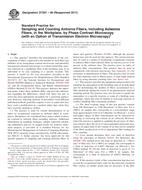
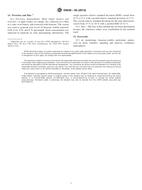 ASTM D4600-95(2010)..
ASTM D4600-95(2010)..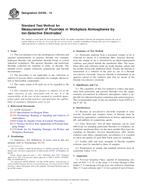 ASTM D4765-13
ASTM D4765-13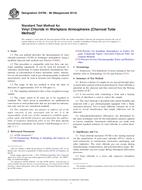 ASTM D4766-98(2014)..
ASTM D4766-98(2014).. ASTM D4856-11
ASTM D4856-11 ASTM D4861-11
ASTM D4861-11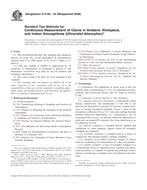 ASTM D5156-02(2008)..
ASTM D5156-02(2008)..
 Cookies
Cookies
